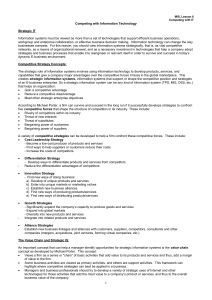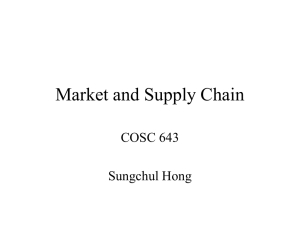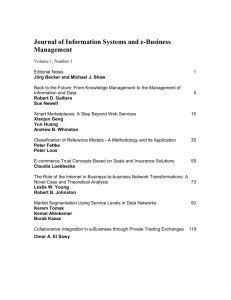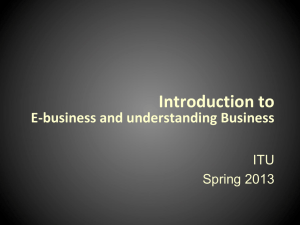competitive advantage by integrated e
advertisement
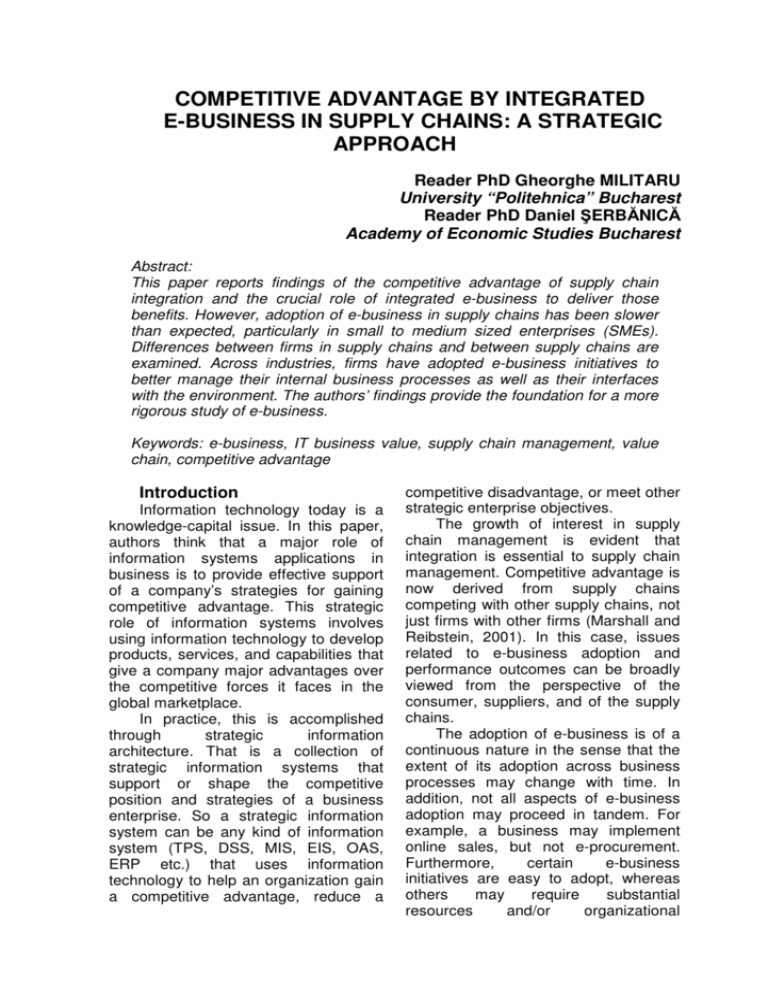
COMPETITIVE ADVANTAGE BY INTEGRATED E-BUSINESS IN SUPPLY CHAINS: A STRATEGIC APPROACH Reader PhD Gheorghe MILITARU University “Politehnica” Bucharest Reader PhD Daniel ŞERBĂNICĂ Academy of Economic Studies Bucharest Abstract: This paper reports findings of the competitive advantage of supply chain integration and the crucial role of integrated e-business to deliver those benefits. However, adoption of e-business in supply chains has been slower than expected, particularly in small to medium sized enterprises (SMEs). Differences between firms in supply chains and between supply chains are examined. Across industries, firms have adopted e-business initiatives to better manage their internal business processes as well as their interfaces with the environment. The authors’ findings provide the foundation for a more rigorous study of e-business. Keywords: e-business, IT business value, supply chain management, value chain, competitive advantage Introduction Information technology today is a knowledge-capital issue. In this paper, authors think that a major role of information systems applications in business is to provide effective support of a company’s strategies for gaining competitive advantage. This strategic role of information systems involves using information technology to develop products, services, and capabilities that give a company major advantages over the competitive forces it faces in the global marketplace. In practice, this is accomplished through strategic information architecture. That is a collection of strategic information systems that support or shape the competitive position and strategies of a business enterprise. So a strategic information system can be any kind of information system (TPS, DSS, MIS, EIS, OAS, ERP etc.) that uses information technology to help an organization gain a competitive advantage, reduce a competitive disadvantage, or meet other strategic enterprise objectives. The growth of interest in supply chain management is evident that integration is essential to supply chain management. Competitive advantage is now derived from supply chains competing with other supply chains, not just firms with other firms (Marshall and Reibstein, 2001). In this case, issues related to e-business adoption and performance outcomes can be broadly viewed from the perspective of the consumer, suppliers, and of the supply chains. The adoption of e-business is of a continuous nature in the sense that the extent of its adoption across business processes may change with time. In addition, not all aspects of e-business adoption may proceed in tandem. For example, a business may implement online sales, but not e-procurement. Furthermore, certain e-business initiatives are easy to adopt, whereas others may require substantial resources and/or organizational restructuring. For example, eprocurement can call for compatible electronic data generation and exchange interfaces across businesses, substantial systems redesign and integration within those businesses, personnel training, and significant commitment from top management. When larger firms in supply chains attempt to impose e-business technologies on other members, SMEs do not have the skill or time to implement all the Intranet applications requested. Firm size also impacts on the level of resources available for investment in information technologies and associated training and education which can inhibit SME adoption. Studies have highlighted that smaller businesses are often less aware of the full potential benefits of e-business. Beyond lack of awareness, SMEs have been shown to exhibit a greater uncertainty of the benefits of IT adoption than larger firms. We next review a conceptualization of e-business. Second, a framework that link the supply chain management, and information technology is presented. Third, the competitive advantages obtain by integrating the ebusiness processes is discussed. It will present how the business can counter the threats of competitive forces that they face by implementing the basic competitive strategies and may obtain the competitive advantages. E-business E-business uses the Internet technologies to link customers, suppliers, business partners, and employees using at least one of the following: (a) e-commerce websites that offer sales transactions, (b) customerservice websites, (c) intranets and enterprise information portals, (d) extranets and supply chains, and (e) IP electronic data interchange. This 28 definition is broadly consistent with the following: “the use of electronic networks and associated technologies to enable, improve, enhance, transform or invent a business process or business system to create superior value for current or potential customers” (Saehney and Zabin, 2001). Both definitions recognize that, by helping to build and manage relationships with customers, suppliers, employees, and partners, e-business can potentially transform a firm into a networked entity with supply chains and value creation processes (Saehney and Zabin 2001). Correspondingly, ebusiness has a impact across the entire span of the organization’s structure from the procurement department to the field sales force and across a range of its business processes, from internal administration to supply-chain coordination. In the context of communication processes, e-business tools facilitate information and knowledge flow within and across the boundaries of the business unit and can help integrate previously truncated information flows into a streamlined knowledge management system (Saehney and Zabin, 2001). However, knowledge is power and managers both within and across departments tends to gather rather than share information, thereby hindering the treatment of information as a shared, corporate asset. The Internet and related technologies and applications have change the way business are operated and people work, and how information systems support business processes, decision making, and competitive advantage. Thus, many businesses today are using Internet technologies to Web-enable business processes and to create innovative e-business applications. See Figure 1. The Internet Company boundary Engineering and research Supply chain management: procurement, distribution, and logistics (SCM) Suppliers and other Business Partners Manufacturing and production extranets Customer relationship management: marketing, sales, and customer service (CRM) Consumers and Business Customers extranets intranets Accounting and finance Figure 1. The Internet creates innovative e-business applications We think that e-business use the Internet technologies to work and empower business processes, electronic commerce, and enterprise collaboration within a company and with its customers, suppliers, and other business stakeholders. In essence, ebusiness can be more generally considered an online exchange of value. The Internet and Internet-like networks – inside the enterprise (intranet) and between an enterprise and its trading partners (extranet) have become the primary information technology infrastructure that supports the e-business applications of many companies. The Supply Chain Management Supply chain management (SCM) is a cross-functional interenterprise system that uses information technology to help support and manage the links between some of a company’s key business processes and those of its suppliers, customers, and business partners. The goal of SCM is to create a fast, efficient, and low-cost network of business relationships, or supply chain, to get a company’s products from concept to market. Supply chain management (SCM) tracks inventory and information among business processes and across companies. Therefore, a supply chain management system is an IT system that supports supply chain management activities by automating the tracking of inventory and information among business processes and across companies. For example, in Figure 2 we can see the basic structure of supply chain. The goal of a comprehensive supply chain management system is to automate the flow of inventory and information across the entire supply chain. The organization would use electronic data interchange (EDI) – the direct computer-to-computer transfer of transaction information contained in standard business documents, such as invoices and purchase orders, in a standard format – to order needed inventory from various manufacturers. Those electronic orders would trigger other systems within the manufacturing companies including the ordering of raw materials and parts from their suppliers and drop shipment schedules sent to the distributing lines. Likewise, when an end customer ordered furniture from a retail outlet, that retail outlet would communicate its needed inventory in similar fashion to manufacturing. To be effective and offer the greatest 29 competitive advantage in the marketplace, all processes that move information would be handled in an Raw Materials Suppliers Manufacturer of Office Furniture automated fashion by EDI within an SCM system. The Internet • Shared market data • Collaborative fulfillment Distributing Lines Your Organization Your Customers Your Customers’ Customers Parts Supplier SCM Integrated Solution: Supplier → Manufacturer → Retailer → Customer Figure 2. Suppliers’ Suppliers and Customers’ Customers in a Supply Chain The value chain views organization as a chain – or series – of processes, each of which adds value to your products or services for your customers. A business process is a standardized set of activities that accomplishes a specific task, such as processing a customer’s order. The value chain approach is an important graphical tool that helps us to identify important business processes within the entire value chain. We can say that the larger the value-added, the more value customers place on our organization’s product or service. To our organization, this can mean a competitive advantage and often greater profits (Marshall and Reibstein, 2001). A company can outperform rivals only if it can establish a difference that it can preserve. Operational effectiveness means performing similar activities better than rivals perform them. It refers to any number of practices that allow a company to better utilize its inputs. Constant improvement in operational effectiveness is necessary to achieve 30 superior profitability. However, it is not usually sufficient. Competitors can quickly imitate management techniques, new technologies, input improvements, and superior ways of meeting customers’ needs. In Romania, for example, Ikea, a global furniture retailer based in Sweden, has a clear strategic positioning. Ikea targets young furniture buyers who want style at low cost, modular, ready-to-assemble furniture to fit its positioning, Ikea has chosen to perform activities differently from its rivals. Identifying processes that add value. Mobexpert is a big furniture maker in Romania are looking at the firm’s business processes and identifying, with help from customers, those processes that add the most value, including above all manufacturing high-quality components and purchasing quality materials. Engineers from Mobexpert should graphically depict customer responses – their opinion of what adds value – on a value chain. In Figure 3 are presented the results of the customer survey results. Notice how the processes in the figure are sized to depict the value that customers attribute to those processes. Management, Accounting, Finance, Legal (2.9%) Human Resource Management (9%) Research and Development (10%) Value Added Purchasing (32%) Receive and store (8%) Make the cars (49%) Deliver (4%) Sell (12%) Service (6%) Figure 3. The Value-Added View of a Mobexpert Source: The customer survey about furniture makers in Romania (2004) The largest value-added source is the high-quality manufacturing process (49%), as these processes are supported by new IT systems. Still, a close second is the purchasing process (32%) that provides access to highquality components and materials. As these processes are the ones that are most visible to the customers, they will quickly add even more value when supported by new IT systems. Therefore, the company has created a computer-aided design system to reduce the time it takes to create and manufacture new models of furniture (Militaru, 2004). Identifying processes that reduce value. After identifying value-added processes, it’s important to identify those processes that reduce value for the customer. Again gathering this information from the customers, the company (Mobexpert) should create a value-reducing value chain. Engineers from Mobexpert identified the deliver process as the process that reduced value the most. Customers were beginning to lose faith in the company’s ability to deliver furniture in time. A well-designed supply chain management system helps the company by optimizing the following: (1) ensuring the right quantity of parts for production or products for sale arrive at the right time, (2) keeping the cost of transporting materials as low as possible consistent with safe and reliable delivery (logistics), (3) ensuring production lines function smoothly because high quality parts are available when needed, (4) ensuring no sales are lost because shelves are empty, and (5) keeping the cost of purchased parts and prices of products at acceptable levels. The value chain of a firm and how IT can be applied to basic business process is illustrated in Figure 4. 31 Management, Accounting, Finance, Legal (Collaborative Workflow Intranet) Human Resource Management (Employee Benefits Intranet) Research and Development (Product Development Extranet with Partners) Competitive advantage Procurement of Resources (e-Commerce Web Portals for Suppliers) Inbound Logistics Automated Just-in- Time Warehousing Operations ComputerAided Flexible Manufacturing Outbound Logistics Marketing and Sells Customer service Online Point –of-Sale Order Processing Targeted Marketing Customer Relationship Management Figure 4. How IT can produce competitive advantage Extranet enable a company and its global business to use the Web to jointly design products and processes. Ecommerce portal can improve procurement of resources by providing online marketplace for a firm’s suppliers. IT can support marketing and sales processes by developing an interactive targeted marketing capability on the Internet and the Web. Creating a loyal B2B customer base is not only about maintaining numbers of customer overtime, but it is also about improving the relationship with business customers to encourage their future purchase and level of support. The loyal customers offer a steady stream of revenue for a company (Kotler, 1994). For example, building customer loyalty has become crucial in the beleaguered airline industry. The callcenter software records conversations and captures ever keystroke, so managers know whether the right actions were taken (Keeney, 2004). In addition, the airline company can use the data to help craft marketing plans and shape overall strategy. New standards are put in place, customer satisfaction rise, and e-ticket sales increase. Intelligent Voice Recognition (IVR) analysis tools usually can help 32 track of and report on a caller’s choices based on which menu paths the caller has taken. The competitive advantages by e-business adoption The businesses frequently adopt innovations to gain competitive advantages or capabilities. An organization may adopt an innovation because it fears being left behind by other organizations that do so. During innovation diffusion, early adopters are more likely to seek efficiency and profit gains, whereas later adoptions may reflect the pursuit of legitimacy (Westphal, Gulati, and Shortell, 1997). Specifically, powerful customers and suppliers may demand the adoption of innovative processes that they perceive will either reduce their costs of, or increase their benefits from, dealing with the focal organization. Companies must be flexible to respond rapidly to competitive and market changes. They must benchmark continuously to achieve best practice. Rivals can quickly copy any market position, and competitive advantage is, at best, temporary. In addition, strategic positions can be based on customers’ needs, customers’ accessibility, or the variety of a company’s products or services (Ramsay, 2001). The tension between the organization’s economic motivations and normative pressures to adopt innovations is particularly relevant in the context of e-business. From a theoretical perspective, Porter’s value chain framework suggests that value creation within a business unit can be traced through distinct stages beginning with the inbound interface (where supplier related processes are concentrated), through the business itself, and culminating at the outbound interface (where customer-related processes are concentrated). Consistent with this view, it emerged from our interviews that managers cognitively clustered e-business activities as pertaining to suppliers, the internal operations of the business, and to customers (Porter, 1985). A capability is the ability of a firm to perform a certain function. A relationship exists between two capabilities when one capability produces an outcome that aids or hinders the performance of the other. Relationships do not necessarily have to be of an enhancing or positive in nature. An outcome of a capability may reduce the effectiveness of another (Varadarajan and Yadov, 2002). For example, the capability to obtain the lowest price by frequently switching suppliers will diminish the capability to build close relationships with suppliers. Capabilities in turn, depend on more tangible assets or resources of the firm, including skills, e.g., direct sales force, product design, software development; and technologies, such as sales databases, mobile connectivity, and data mining software. Resources represent the tangible (people, policies, capital, technology, etc.) and intangible (brands, etc.) assets of the firm. Usually, resources have a finite capacity to support a firm’s activities (Blois, 1999). A company can survive and succeed in the long run only if it successfully develops strategies to confront five competitive forces that shape the structure of competitive in its industry. In Michael Porter’s classic model of competition, any business that want to survive and succeed must develop and implement strategies to effectively counter (1) the rivalry of competitors within its industry, (2) the threat of new entrants into an industry and its markets, (3) the threat posed by substitute products which might capture market share, (4) the bargaining power of customers, and (5) the bargaining power of suppliers. Figure 5 illustrates that businesses can counter the threats of competitive forces that they face by implementing five basic competitive strategies: cost leadership, differentiation, innovation growth, alliance, building switching costs, raising barriers to entry, locking in customers or suppliers, and leveraging investment in information technology. The Internet has created many ways for a new entrant to enter the marketplace quickly and with relatively low cost of entry. In the Internet world, a firm’s biggest potential competitors may be one that is not yet in the marketplace but could emerge almost overnight (Schoenherr and Mabert, 2006). The threat of substitutes is another competitive force confronting a business. When airplane prices get too high, people substitute car travel on their vacations. Most products or services have some sort of substitute available to the consumer. A company may make use of one, or all of the strategies in varying degrees to manage the forces of competition (the strategies are not mutually exclusive). By implementing a systems that allows customers to track their order or shipment online could be considered a form of differentiation if the other competitors in the marketplace do not offer this service. 33 Competitive forces • Rivalry of competitors • Threat of new entrants • Threat of substitutes • Bargaining power of customers • Bargaining power of suppliers COMPETITIVE ADVANTAGE A. Achieving of competitive advantage: - online build to order - online seller bidding - online auctions - online customer design - customer online shipment tracking - virtual manufacturing alliances - POS inventory tracking - others B. A competitive necessity for sustain the advantage over the long term: - customer loyalty - customer commitment - organizational and employees trust - customer satisfaction - relationship quality Competitive strategies Cost leadership Differentiation Innovation Growth Alliance Figure 5. Business can develop competitive strategies to obtain the competitive advantages If an organization offers their online package tracking system in a manner that allows their customers to access shipment information not only via a computer, but via a mobile phone as well, then such an action could fall into both the differentiation and innovation strategy categories. A company can use IT to substantially reduce the cost of business process or to lower the costs of customers or suppliers. By differentiate; it develops new IT features to differentiate products and services to reduce the differentiation advantages of competitors, or to focus products and services at selected market niches (Keeney, 2004). Innovation strategies create new products and services that include IT components, develop unique new markets or market niches with the help of IT, and make radical changes to business process with IT that dramatically cut costs, improve quality, efficiency, or customer service, or shorten time to market (Wagner and Buko, 2005). 34 A company can use IT to manage regional and global business expansion, to diversify and integrate into other products and services. It develops alliances by using IT to create virtual organizations of business partners. Develop interentreprise information systems linked by the Internet and extranets that support strategic business relationships with customers, suppliers, subcontractors, and others. Investments in IT can allow a business to lock in customers and suppliers by building valuable new relationships with them. For example, a company (retailer) realizes the benefits of using IT by investing in an elaborate satellite network linking the point-of-sale terminals in all of its facilities. This system may grow into complex communication network that connected its headquarters and distribution centers, and all of its major suppliers. The most innovative aspect of the system was the facilitation of a modified just-in-time process of inventory control. When an item is sold by a facility (store), a message is immediately sent to the supplier of that item. The supplier is alerted to include a replacement in the next scheduled shipment to the nearest distribution hub. This tight connectivity allows an immediate response to inventory needs while significantly reducing the amount of inventory required. However, the company may realize an operational efficiency of its system and used it to offer lower cost, better quality products and services, as well as to differentiate itself from its competitors (O’Brain Marakas, 2007). A major emphasis in strategic information systems has been to find ways to build switching costs into the relationships between a firm and its customers or suppliers. That is, investments in information systems can make customers or suppliers dependent on the continued use of innovative, mutually beneficial interenterprise information systems. Then they become reluctant to pay the costs in time, money, effort, and inconvenience that it would take to switch to a company’s competitors. A firm could erect barriers to entry that would discourage or delay other companies from entering a market. Typically, this happens by increasing the amount of investment or the complexity of the technology required to compete in an industry or a market segment. Such action would tend to discourage firms already in the industry and to deter external firms from entering the industry. The banking industry is a good example in this case. The real problem with a competitive advantage is that it normally doesn’t last very long and is generally not sustainable over the long term. Once a firm figures out how to gain an advantage over its competitors, the competitors figure out how it was done, and they do the same thing. That is, what was once a competitive advantage is now a competitive necessity. The ability to learn faster than your competitors may be the only sustainable competitive advantage in the future. Conclusions The main barriers to supply chain information integration discussed here are lack of strategic alignment of information strategies in the chain, firm size of some supply chain actors, lack of awareness of potential benefits of ebusiness, lack of motivation, and being in a less developed industry or regional context. Specifically it examines the barriers to adoption of e-business technologies and therefore to achievement of integrated information in supply chains. Our findings suggest that many industries from Internet retailing to highend personal services have the capability to customize their service to individual customers. An Internet retailer can customize a Web page to present past information, remember key ordering information, and forward targeted information to the buyer (e.g. Amazon.com). Customizing services to meet the needs of individual customers is probably closer to the concept of loyalty and a relationship. However, a complete understanding of customization strategies requires an understanding of the cost of different types of customization. Customization can also lead to price discrimination. 35 REFERENCES [1] Blois, K., Trust in business to business relationships: an evaluation of its status, Journal Management Science, Vol. 36, NY, 1999. [2] Keeney, R., The value of Internet Commerce to the Customer, Management Science, Vol. 45, NY, 2004. [3] Kotler, P., Marketing Management, Prentice Hall, NJ, 1994. [4] Marshall, F., Reibstein, D., Technology-driven Demand: Implications for the Supply Chain, John Wiley, New York; 2001. [5] Militaru, Gh., Sisteme Informatice pentru Management, Editura All, Bucureşti, 2004. [6] O’Brain Marakas, 2007. Enterprise Information Systems, McGraw-Hill, New York, [7] Porter, Michael, Competitive Advantage: Creating and Sustaining Superior Performance, Free Press, New York, 1985. [8] Ramsay, J., The Resource Based Perspective, Rents, and Purchasing’s Contribution to Sustainable Competitive Advantage, The Journal of Supply Chain Management, Vol. 37, New York, 2001. [9] Saehney and Zabin, The Seven Steps to Nirvana, McGraw-Hill, New York, 2001. [10] Schoenherr, T., and Mabert, V., Bundling for B2B Procurement Auctions: Current State and Best Practices, International Journal of Integrated Supply Management, Vol. 3, New York, 2006. [11] Varadarajan, R., Yadav, M., Marketing Strategy and the Internet: An Organizing Framework, Journal of the Academy of Marketing Science, Vol. 30, 2002. [12] Wagner, S., and Buko, C., An Empirical Investigation of Knowledge-Sharing in Networks, The Journal of Supply Chain Management, Vol. 41, NJ, 2005. [13] Westphal, D., Gulati, R., and Shortell, S., Customization or Confirmity? An Institutional and Network Perspective on the Control and Consequences of TQM Adoption, Administrative Science Quarterly, Vol. 16, 1997. [14] Wetzels, M., Marketing service relationships: the role of commitment, Journal Business Industrial Marketing, Vol.13, NJ., 1998. 36
